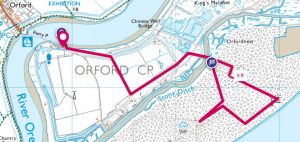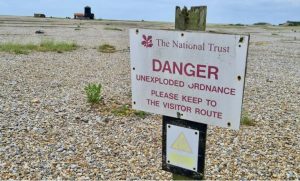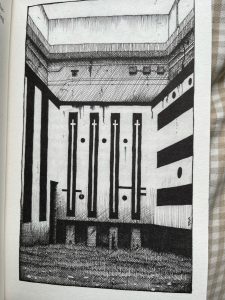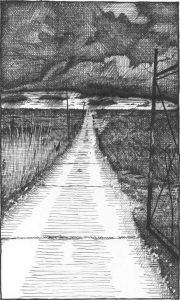‘Nowhere has drawn me back more often’
‘It has become a sort of Tintern Abbey for the contemporary’
‘A metonym for a state we are now in, a clash and crisis and juxtaposition’
The Inspiration for this walk: ‘Ness’ 2018
It was Robert Macfarlane’s ‘Mountains of the Mind’ that first grabbed my imagination, but there are many other great works that he has since added to what is becoming a major body of work. A modest but thought-provoking addition is ‘Ness’, a book about this mysterious spit of land just off the coast, where man has briefly interrupted nature.

KEY DATA
 Terrain: Orford Ness was a bombing and firing range for eighty years. Unexploded ordnance is still found here. Keep to the paths and do not touch suspicious objects.
Terrain: Orford Ness was a bombing and firing range for eighty years. Unexploded ordnance is still found here. Keep to the paths and do not touch suspicious objects.- Starting point: Access is only via the National Trust ferry Octavia from Orford. Tickets are limited and must be booked in advance. Visit https://www.nationaltrust.org.uk/orford-ness-national-nature-reserve for details
- Distance: 4.3 km (2.7 miles)
- Walking time: 1 hrs 5 mins
- OS Map: https://explore.osmaps.com/route/11541756/orford-ness?lat=52.088707&lon=1.549484&zoom=14.1263&style=Leisure&type=2d
- Facilities: WC on Orford Ness, but no café or shop, so bring your own food & drink. WC, tearoom and pubs at Orford Quay and village.
Robert MacFarlane (1967-
If there was a nature writers’ Guild, Robert MacFarlane would be appointed its chairperson by acclaim, and all meetings would have to be in the mountains, underground or by a spring. Barely any self-respecting book connected to nature does not have his support on the front cover or better still a preface to the work.
My claim to fame is that one of my books, Pathways, is referenced in the index to his great book about walking ‘The Old Ways’.
ORFORD NESS
Robert Macfarlane writes: ‘Lying just off the Suffolk coast is a desert. Orford Ness is a vast shingle spit, some 12 miles long and up to a mile wide, which curls offshore round from Aldeburgh down to Hollesley. For most of the 20th century, the Ness was owned by the Ministry of Defence, for whom its natural security and secrecy made it the ideal military test site. Bomb ballistics, gun gears, phosphorous shells, nuclear detonators: for 80 years, the physics of death was tested and perfected out there on the shining expanses of flint.
‘Though it now belongs to the National Trust, the site still feels militarised. Across the Ness, enigmatic structures jut from the shingle: barracks, armouries, listening stations, beacons, watchtowers, bunkers, and two huge blast-chambers nicknamed the pagodas. It is an architectural rattle-bag that includes concrete brutalism, Dutch woodcraft, East Anglian tabernacle barns and Nissen huts.
‘The Trust pursues the finely named policy of “controlled ruination”, which sounds like a South African rugby strategy, but in conservation terms means allowing entropy its play. Here, there is little of the painstaking repair work that goes on at most Trust-owned properties. When glass shatters or tarmac cracks, it is left unfixed. Rust spreads in maps. Buildings dilapidate. The splintered, the fissile, the ruderal: these are the Ness’s textures.
‘The Ness is also a wild place. It is front-line North sea: big storms chew hard at it in winter. Its mixture of mudflat, salt marsh, grassland and shingle is hunted over by marsh harriers and peregrines. Avocets, curlews and whimbrels probe its rich mud. Lesser black-backed gulls breed on and around the pagodas. An eerie and intricate landscape, then, in which the military and the natural combine, collide and confuse. Brambles coil and loop like barbed wire. Orange lichen camouflages the concrete of pill-boxes.’
‘The Ness, like other east coast spits (Spurn Head, Blakeney Point, Dungeness), is a dynamic structure. Created and shaped by tide, current, shore-drift and weather, it is in continual slow migration, forming and reforming over time. Spurn Head, when mapped across centuries, appears to lash like a tail. The distal point of Orford Ness can extend and retract by miles within decades. Storms throw up new ridges and swales of shingle along its outer edge, fattening the spit.
‘Arnie and I agreed early on that we wanted the Ness’s volatility as a landscape to be a formal principle of our work. Arnie’s expertise as a double bassist was well suited to this, and it became clear that the eventual performance would include major elements of jazz improvisation.
‘I have long been fascinated by the many languages of the Ness: the specialist dialects (military-technological, ornithological, geological, conservationist) that it has generated; the many voices (human, avian, mineral) with which it seems to speak. It is a profoundly polyglot place. Also fascinating to me is the discourse migration that has occurred between those voices: the mist that rolls in off the North sea; the mist-nets that the ornithologists use to trap and ring migrant birds; the Cobra Mist listening station, designed to eavesdrop on the Soviet Union.
NESS
In 2018 Robert Macfarlane published ‘Ness’, a short book that, in the words of the Guardian, ‘seems to blend the symbolic oddity of medieval mystery plays with the lyrical strangeness of Anglo-Saxon poetry’; and is interspersed with Stanley Donwood’s haunting line drawings.
The story, such as it is, revolves around five characters – ‘it, he, she, they, as’ – who approach and overrun the Ness:
‘All five know where they must go &
With what they must grapple &
Where they must go is to the Green Chapel’
These five are natural forces that can overwhelm a place: the drift of tides and currents that can shift the spit in a storm; or fungi that, ‘If you left her on a rock, given time, she would crack it with her acids.’
 Inside the Green Chapel – one of the cathedral-like concrete pagodas – stands a group of scientists that includes an Engineer, an Ornithologist, a Botanist, a Physicist, and a Bryologist, who are led by an Armourer in reciting ‘The Firing Song’ that will begin a nuclear weapons test.
Inside the Green Chapel – one of the cathedral-like concrete pagodas – stands a group of scientists that includes an Engineer, an Ornithologist, a Botanist, a Physicist, and a Bryologist, who are led by an Armourer in reciting ‘The Firing Song’ that will begin a nuclear weapons test.
These two groups are set in opposition in a dramatised version of the long-running battle between humans and nature. And, as with Orford Ness itself, the hubristic pursuits of mankind are overwhelmed by the unrelenting timeless forces of nature.
‘Listen. Listen now. Listen again to the sounds of this slow-flowing shingle river. Listen to the voices of this untrue island. Listen to the Ness: it speaks gull, it speaks wave, it speaks rust, it speaks lichen. Hear the Ness: it speaks bullet, it speaks ruin, it speaks redshank, it speaks deception, it speaks pagoda, it speaks transmission, it speaks reception, it speaks pure mercury, it speaks fluent flint, it speaks utmost secret, it speaks swift current, it speaks broken signal, it speaks shifting shingle, it speaks precarious wisdom, it speaks rapid-fire.’
The style is unfamiliar and hard to assimilate, it reminds me in tone of ‘Crow’ by Ted Hughes and in mood of Tacita Dean’s ‘Teignmouth Electron’, an eerie 20-minute video in memory of Donald Crowhurst’s ill-fated attempt to sail around the world in the Golden Globe Race of 1968.
OTHER WRITERS INSPIRED BY THE NESS
Over the decades, musicians, filmmakers, artists and writers have been sucked into its ghostly orbit, captivated by what the great existential wanderer WG Sebald imagined as ‘the remains of our own civilisation after its extinction in some future catastrophe’. He wrote of his visit there in The Rings of Saturn (1995): ‘Where and in what time I truly was that day at Orford Ness I cannot say, even now as I write these words.’
If you look online, you will find all sorts of artistic references to the place, including Cobra Mist, an evocative film by Emily Richardson that takes an unsettling tour of the site to a soundtrack by Chris Watson.
Months before its demolition in 2020, the lighthouse was memorialised in a film and music project by the singer-songwriter Thomas Dolby, as the symbolic centre of a docu-tour of the area he grew up in. Orford Ness ‘has seeped into my chord changes and lyrics’ he says in ‘The Invisible Lighthouse’, which begins with a beam of light sweeping round as handwritten words appear on the screen.
DIRECTIONS
- Take the Octavia ferry from Orford Quay to the Ness and hand in your ticket.
 Follow the red arrows. As you approach the Information Building, look around you at the First World War airfields and later firing ranges. These are now used by breeding waders and wintering wildfowl.
Follow the red arrows. As you approach the Information Building, look around you at the First World War airfields and later firing ranges. These are now used by breeding waders and wintering wildfowl.- Visit the information displays in the former site HQ to find out more about the Ness’s ecology and history. Exit the buildings and return to the marked red trail. Pass the WCs on your left and at the “gate” the track climbs upwards to the right towards the bridge.
- Cross the Bailey bridge, taking you over Stony Ditch, and follow the red arrows ahead taking the left fork.
- On reaching the Bomb Ballistics Building, climb to the top for superb views over the shingle and marsh. It was once a control centre for the bombing ranges.
- Continue following the red arrows to the sight of the former lighthouse. From here, drop down onto the beach and turn right along the shore to reach the Police Tower. Turn inland and follow the red arrows.
- Take a look at the information displayed at the Black Beacon and Powerhouse. Return to the main roadway, turning left to walk to the Atomic Weapons Research Establishment site
- Laboratory No 1. The first experiment on an atomic bomb at Orford Ness took place here. Return to the Black Beacon, then turn left back to the bridge. Cross it and follow the red arrows to your start point.
OTHER STUFF
- Visit: Orford Castle, which dates back to the twelfth century
- Book: a table at Pinneys, run by the third generation of the same family, offering oysters, smoked delicacies, fresh local fish and shellfish


Leave a Reply